Foraging for dandelions to blend your own detox tea is an enjoyable way to tap into nature's benefits. Look for the distinctive jagged leaves and bright yellow flowers in lawns or meadows. Make sure to harvest from pesticide-free areas and use clean tools for your gathering. After rinsing, chop the leaves, roots, and flowers, then steep them in hot water to create a flavorful brew. You can even enhance the taste by blending with herbs like ginger or mint. This experience connects you to the earth while supporting your health, and you'll discover plenty of tips ahead!
Understanding Dandelion Benefits

Dandelion, often dismissed as a pesky weed, actually packs a punch when it comes to health benefits. You might be surprised to learn that this vibrant plant is rich in vitamins A, C, and K, along with essential minerals like potassium and calcium. Incorporating dandelion into your routine can support your overall wellness.
One of the standout benefits of dandelion is its ability to promote liver health. It acts as a natural diuretic, helping your body eliminate toxins and reduce water retention. This cleansing effect can lead to improved digestion and better skin health.
Plus, dandelion is known to aid in balancing blood sugar levels, making it a great ally for those managing diabetes.
You'll also find that dandelion is anti-inflammatory, which can help ease discomfort from various conditions. Its antioxidant properties protect your cells from damage, potentially lowering the risk of chronic diseases.
Identifying Dandelion in the Wild
When exploring the great outdoors, the thrill of discovery awaits as you learn to identify dandelion in the wild.
These vibrant plants are easily recognizable, thanks to their distinctive features. Look for the rosette of jagged, deeply lobed leaves that rise close to the ground. The leaves can be smooth or slightly hairy, and they usually have a glossy appearance.
Dandelions produce bright yellow flowers that sit on long, hollow stems. Each flower head is made up of numerous tiny florets, which can transform into a fluffy white seed puff when they mature. This transformation is a key identification marker; you may spot the puffs blowing away in the wind.
Dandelions thrive in a variety of environments, from lawns to meadows, and even cracks in sidewalks. They're often among the first plants to bloom in spring, which makes them easier to spot.
Remember to observe their growth habit and surroundings, as this helps you distinguish them from similar-looking plants. With practice, you'll soon feel confident in your ability to identify dandelions during your outdoor adventures.
Happy foraging!
Best Foraging Practices

Foraging for dandelions can be a rewarding experience, but it's essential to follow best practices to guarantee safety and sustainability.
First, always choose foraging locations wisely. Avoid areas close to roads, industrial sites, or places that may have been treated with pesticides. Look for dandelions in organic gardens or wild spaces away from human activity.
Next, familiarize yourself with local regulations. Some areas have restrictions on foraging, especially in public parks, so check local laws to confirm you're foraging legally.
Be mindful of the ecosystem; never harvest more than you need and leave enough for the plants to thrive and for wildlife that depends on them.
It's also important to practice ethical foraging. Respect private property and always ask for permission if you're foraging on someone else's land.
When you're ready to forage, bring a clean basket or cloth bag to avoid damaging the plants and to keep your harvest fresh.
Lastly, keep track of the weather. Foraging after a rain is ideal, as dandelions are often more abundant and easier to spot.
Harvesting Dandelion Leaves and Roots
When you're ready to harvest dandelion leaves and roots, finding the right locations is essential.
Look for areas free from pesticides and pollution to guarantee your tea is pure and potent.
Next, let's explore some effective techniques for harvesting these beneficial plants.
Best Foraging Locations
Exploring local parks and green spaces can lead you to some of the best foraging locations for dandelion leaves and roots. These vibrant areas often host abundant patches of dandelions, making them perfect spots for your foraging adventures.
Here are some ideal locations to check out:
- Community gardens: These often have dandelions growing among the vegetables, offering a fresh source for your tea.
- Nature trails: Look along the edges or in sunny clearings; dandelions thrive in disturbed soil.
- Abandoned lots: These forgotten spaces can be treasure troves of wild edibles, including dandelions.
- Meadows: Open fields with plenty of sunlight are excellent for finding healthy dandelion plants.
When you're foraging, always remember to seek out areas that haven't been treated with pesticides or chemicals.
Going for a leisurely walk in these locations not only enriches your herbal pantry but also allows you to connect with nature.
As you gather dandelion leaves and roots, you'll appreciate the simple joy of foraging while preparing yourself for a delightful detox tea.
Happy foraging!
Harvesting Techniques Explained
After you've located an ideal spot for gathering dandelions, it's time to focus on the best ways to harvest the leaves and roots. You'll want to use clean, sharp tools to guarantee a smooth process. For leaves, a small knife or scissors works well. Gently cut the leaves close to the base, taking care not to damage the plant. Pick only the younger, tender leaves, as they're best for your tea.
When harvesting roots, it's a bit more labor-intensive. Use a digging fork or trowel to carefully loosen the soil around the root. Pull the root straight out, avoiding any twisting that might break it. Make sure you're harvesting roots from healthy plants, as these will provide the best flavor and nutrients.
Here's a quick reference table to help you remember the key techniques:
| Part | Technique |
|---|---|
| Leaves | Cut close to the base |
| Roots | Dig and pull straight out |
| Timing | Early spring/late fall |
| Tools | Knife or digging fork |
| Care | Avoid damaging plants |
With these techniques, you'll be well on your way to foraging success!
Preparing Dandelion for Tea

Preparing dandelion for tea is a straightforward process that opens the door to a wealth of health benefits. First, you'll need to gather fresh dandelion leaves, roots, and flowers. Make sure they're free from pesticides and pollutants.
Once you have your bounty, follow these easy steps to prepare your tea.
- Clean the Dandelion: Rinse the leaves and flowers under cool water to remove any dirt or insects. If you're using roots, scrub them thoroughly.
- Chop and Dry: Cut the leaves and flowers into smaller pieces. For roots, slice them thinly. You can use them fresh or dry them in a well-ventilated area.
- Steep the Ingredients: Place your chopped dandelion parts in a teapot, add hot water, and let them steep for about 5-10 minutes.
- Strain and Serve: After steeping, strain the tea into your favorite cup. You can enjoy it plain or sweetened with honey.
Now you're ready to savor your homemade dandelion tea, packed with nutrients and flavor!
Enjoy the invigorating taste and health perks it brings.
Blending With Other Herbs
Blending dandelion with other herbs can enhance your tea's flavor and health benefits.
You'll want to contemplate complementary herbal properties and experiment with flavor pairing techniques to create a balanced blend.
Complementary Herbal Properties
When crafting your dandelion detox tea, consider the benefits of blending it with other herbs to enhance its properties. Each herb brings unique qualities that can complement dandelion's detoxifying effects, making your tea not just delicious but also more beneficial for your body.
Here are some fantastic options to think about:
- Nettle: Known for its anti-inflammatory properties, nettle can support your kidneys while providing a rich source of vitamins and minerals.
- Ginger: With its warming effect, ginger can aid digestion and add a spicy kick, promoting overall wellness.
- Peppermint: This invigorating herb can enhance digestion and balance the bitterness of dandelion, creating a more harmonious blend.
- Lemon Balm: Recognized for its calming effects, lemon balm can help reduce stress, adding a soothing element to your detox experience.
Experimenting with these herbs not only diversifies the flavor but also boosts the nutritional profile of your dandelion detox tea.
Flavor Pairing Techniques
Creating a flavorful dandelion detox tea involves more than just adding herbs; it's about understanding how different flavors interact. When you blend dandelion with other herbs, consider their taste profiles and how they can complement or contrast with dandelion's slightly bitter notes.
Here are some effective flavor pairings to enhance your tea:
| Herb | Flavor Profile |
|---|---|
| Peppermint | Invigorating and cool |
| Ginger | Spicy and warming |
| Lemon Balm | Citrus-like and calming |
| Calendula | Floral and mildly sweet |
Health Benefits Synergy
Combining dandelion with other herbs can amplify the health benefits of your detox tea. When you blend dandelion, known for its liver-supporting properties, with complementary herbs, you create a powerhouse of wellness.
Here are some fantastic options to contemplate:
- Nettle: Rich in vitamins and minerals, nettle enhances dandelion's detox effects and supports kidney function.
- Ginger: This warming spice boosts circulation and digestion, making your detox tea more effective in eliminating toxins.
- Peppermint: Known for its soothing properties, peppermint can enhance the flavor while aiding digestion and reducing bloating.
- Lemon Balm: This calming herb adds a rejuvenating taste and helps alleviate stress, making your detox experience more enjoyable.
Brewing the Perfect Detox Tea

To brew the perfect detox tea, start by selecting high-quality dandelion leaves and roots, which are known for their cleansing properties. Look for vibrant green leaves and firm roots, ensuring they're free from pesticides. Rinse them thoroughly to remove any dirt.
Next, chop the leaves and roots into smaller pieces to maximize the extraction of their beneficial compounds. Boil water in a pot, using about two cups for every tablespoon of dandelion. Once the water reaches a rolling boil, add your chopped dandelion. Reduce the heat and let it simmer for 10 to 15 minutes. This allows the flavors and nutrients to infuse into the water.
After brewing, strain the tea into your favorite mug, discarding the plant material. You can enjoy it as is, or enhance the flavor with a squeeze of lemon or a drizzle of honey.
These additions not only complement the dandelion's earthy taste but also bring their own health benefits.
Storage Tips for Dandelion Tea
Proper storage of dandelion tea can extend its freshness and potency for up to a week. To guarantee you enjoy the best flavor and benefits, follow these simple storage tips.
First, let your tea cool to room temperature before storing. Placing hot tea in a container can create condensation, which may lead to spoilage.
Once cooled, transfer your tea to an airtight container. This helps prevent exposure to air and moisture, which can degrade the quality.
Here are some essential storage tips to keep in mind:
- Use glass or BPA-free plastic containers to avoid leaching flavors.
- Store in a cool, dark place away from sunlight, which can cause the tea to lose its potency.
- Label your containers with the date you brewed the tea for easy reference.
- Consider refrigerating if you live in a warm climate, as this can help maintain freshness longer.
Enjoying Your Herbal Experience
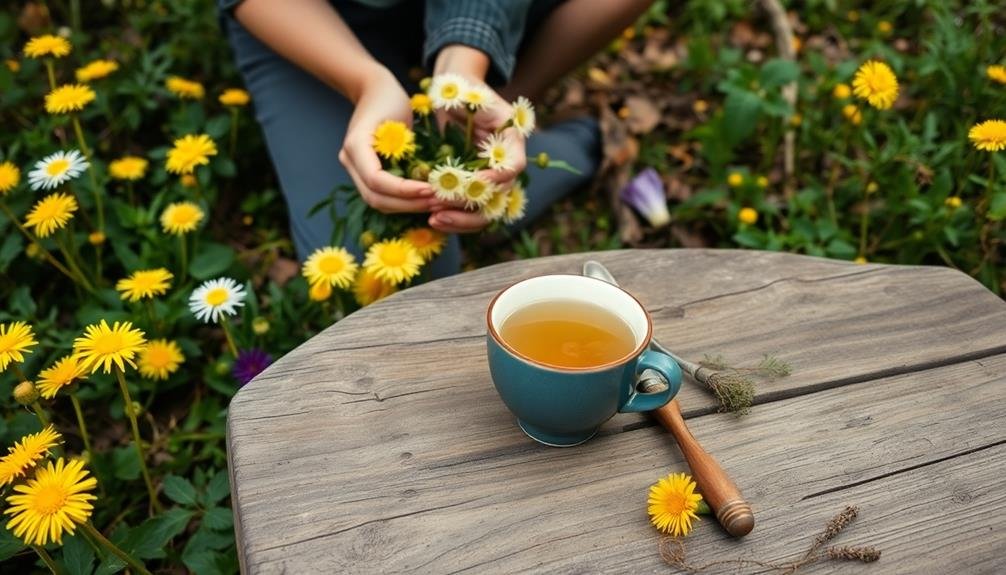
After you've stored your dandelion tea properly, it's time to focus on how to truly enjoy your herbal experience.
Start by selecting the right moment to indulge in your tea. Create a calming atmosphere—dim the lights, play soft music, or find a cozy spot in your home. This sets the stage for a mindful tea-drinking ritual.
Next, prepare your dandelion tea with care. Boil fresh water, let it cool slightly, and steep the tea for the recommended time. As the aroma fills the air, take a moment to appreciate the earthy scent.
When you take your first sip, let the flavors unfold on your palate. Notice the natural bitterness, which is a hallmark of dandelion.
Consider enhancing your tea with natural sweeteners like honey or a slice of lemon. Experiment with different additions to find what resonates with your taste buds.
Finally, allow yourself to savor each sip, focusing on how this herbal experience benefits your body and mind. Embrace the moment, and reflect on the connection you've cultivated with this powerful plant.
Enjoy your dandelion detox tea to its fullest!
Frequently Asked Questions
Can I Use Dandelions From My Garden for Tea?
Yes, you can use dandelions from your garden for tea! Just make sure they've been grown without pesticides. Harvest the leaves, flowers, or roots, then rinse them well before brewing your invigorating herbal tea. Enjoy!
Are There Any Risks Associated With Foraging Dandelions?
Yes, there are risks when foraging dandelions. You might accidentally collect contaminated plants, or confuse them with toxic look-alikes. Always guarantee you're foraging in clean areas and correctly identifying the plants before consuming them.
How Long Does Dandelion Tea Stay Fresh?
Dandelion tea stays fresh for about 3 to 5 days when stored in the refrigerator. If you freeze it, it can last for several months. Just remember to keep it in an airtight container.
Can Dandelion Tea Interact With Medications?
Yes, dandelion tea can interact with certain medications. It's important you consult your healthcare provider before consuming it, especially if you're on diuretics, blood thinners, or medications for diabetes to avoid potential complications.
What Is the Best Time of Year to Forage Dandelions?
The best time to forage dandelions is in early spring, before they bloom. You'll find them tender and flavorful then. Just make sure you're picking from areas free of pesticides or pollutants for safety.
In Summary
Now that you know how to forage, prepare, and blend dandelion for a detox tea, you're ready to enjoy its numerous benefits. Embrace the process of connecting with nature while savoring the unique flavors of your homemade brew. Remember, each cup is not just a drink but an experience that nourishes your body and soul. So, gather your herbs, brew your tea, and take a moment to appreciate the healing power of dandelions in your daily routine!

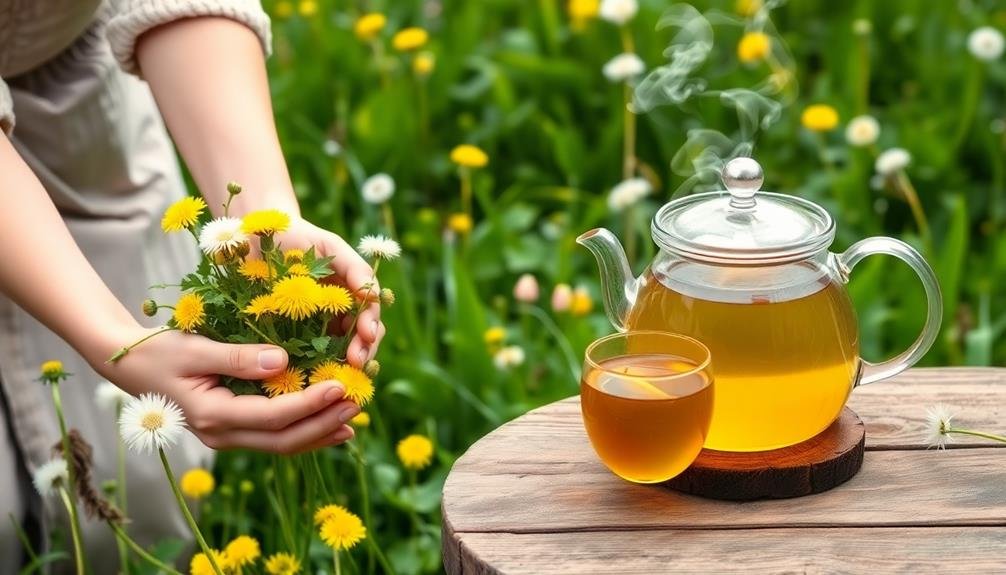
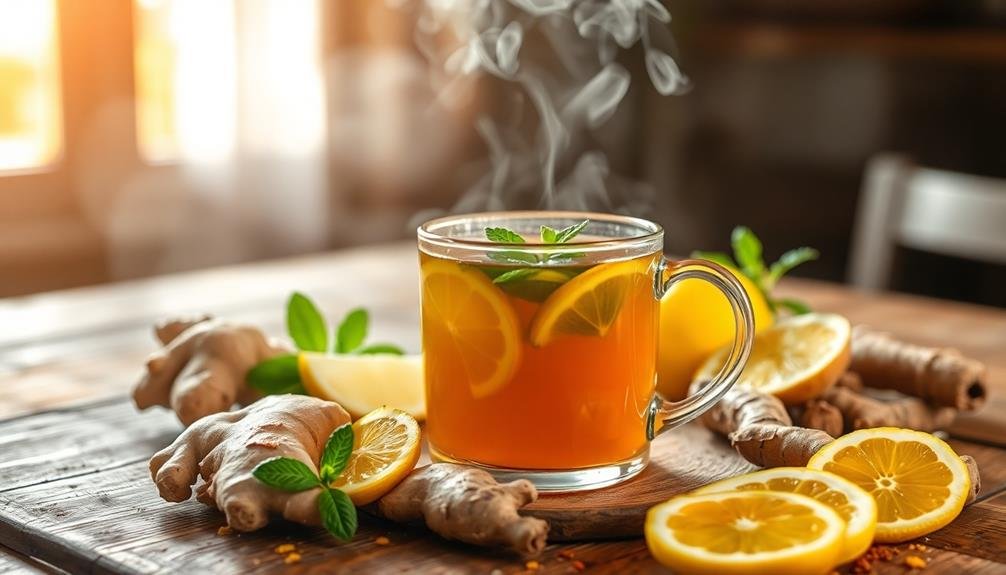
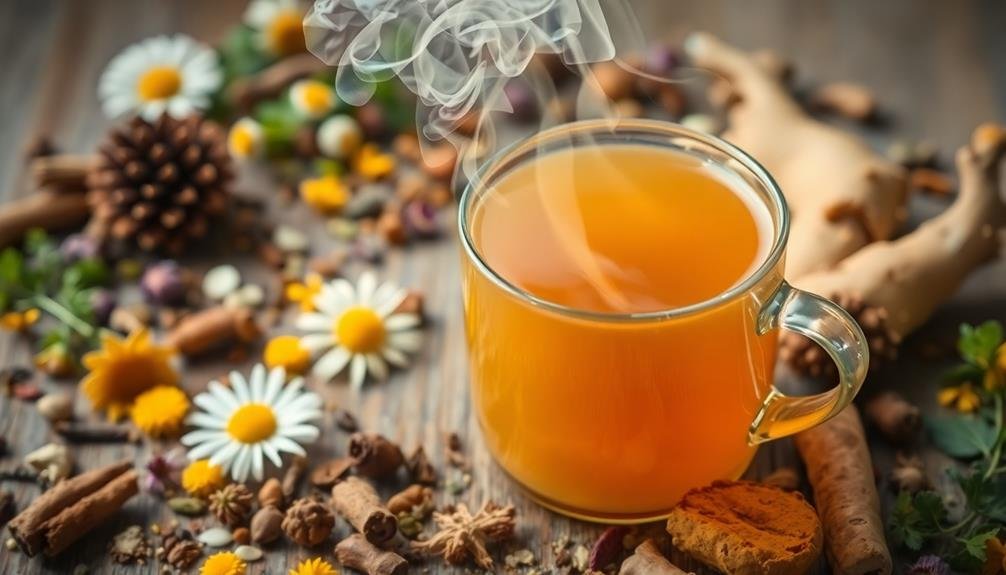
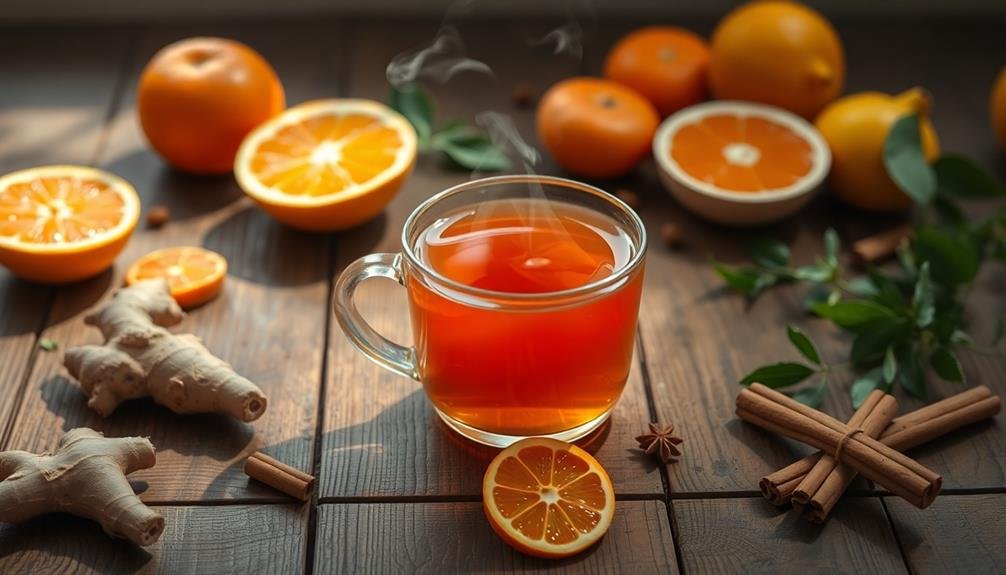
Leave a Reply